Dispatch from Ein Hod and Occupation Normalization – Sunday, July 30, 2023
By Claire Schnatterbeck
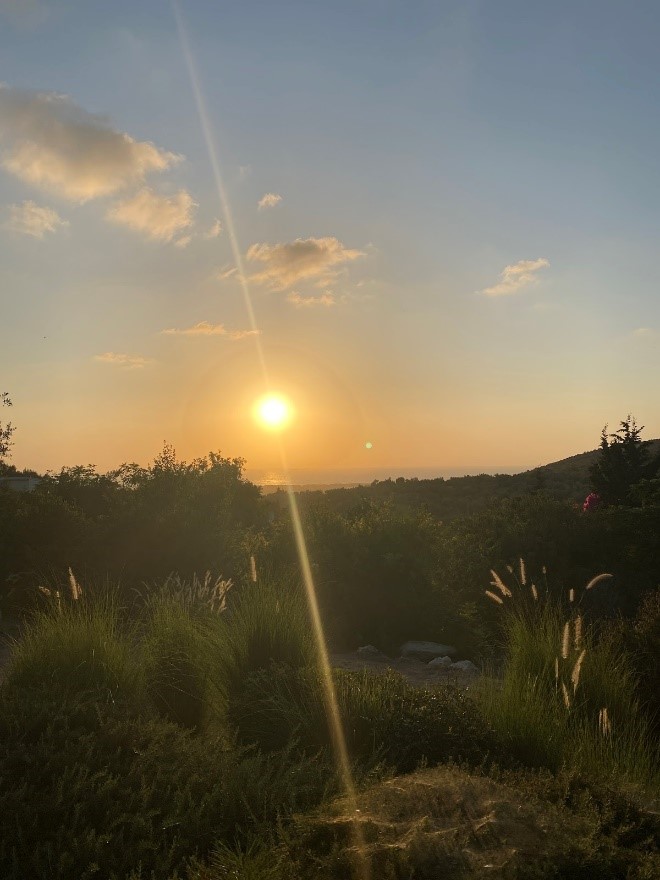
Caption: A gold-hour view of the Mediterranean Sea from the Ein Hod Artists Village.
EIN HOD—While returning to Ramallah from Haifa, IFP students made a stop at the Ein Hod Artists Village. While the golden light of the setting sun made the village look like a beautiful oasis surrounded by olive trees and a stunning view of the Mediterranean Sea, closer research into the location's history brought a more insidious vibe to the pit stop.
Nestled at the foot of Mount Carmel, southeast of Haifa, the community settlement was formerly the Palestinian village of Ein Hawd. However, the Palestinian population was forcibly expelled during the 1948 Nakba, with many former residents resettling in the West Bank and the Jenin refugee camp.
Ein Hod became an artists' colony in 1953 and now serves as a space for Israeli artists and creatives. The village mosque was converted into a restaurant-bar and the old buildings were turned into homes for the artists. Sculptures and photographs from the artists are scattered all over the landscape.
This settlement is a stark example of how Israeli occupation has been “normalized” by liberal Israelis who may even see themselves as Palestine supporters. While “normalization” has many definitions, it is often used in situations where communities are engaging or cooperating with institutions linked to Israeli occupation. It could also be seen as contact with Israelis who do not recognize the occupation, and are not actively working for the freedom of Palestinians.
While not purely an ideological or religious settlement, Ein Hod bears the signs of how Israeli occupation has been aestheticized in the surroundings and the people. The romanticized, artsy vibe masks the true violence of the occupation under a guise of creative expression. In one art piece, tiles made to resemble the iconic Palestinian floor tiles were covered in writing and sketches. One of the tiles read “Arab is the new black.” What is the purpose of making art critiquing the occupation ON occupied land? What about the Palestinian artists who could gain creative inspiration from the gorgeous landscape?
When the IFP students visited, the colony felt almost deserted, with the only tangible signs of life being animals roaming around. It felt surreal to walk around—especially after visiting Haifa where Palestinians and Israelis supposedly “cohabitate”—a beautiful landscape and imagine the Palestinian village it used to be.
Dispatch from Aida Camp مخيم عايده – Saturday, July 22, 2023
By Claire Schnatterbeck
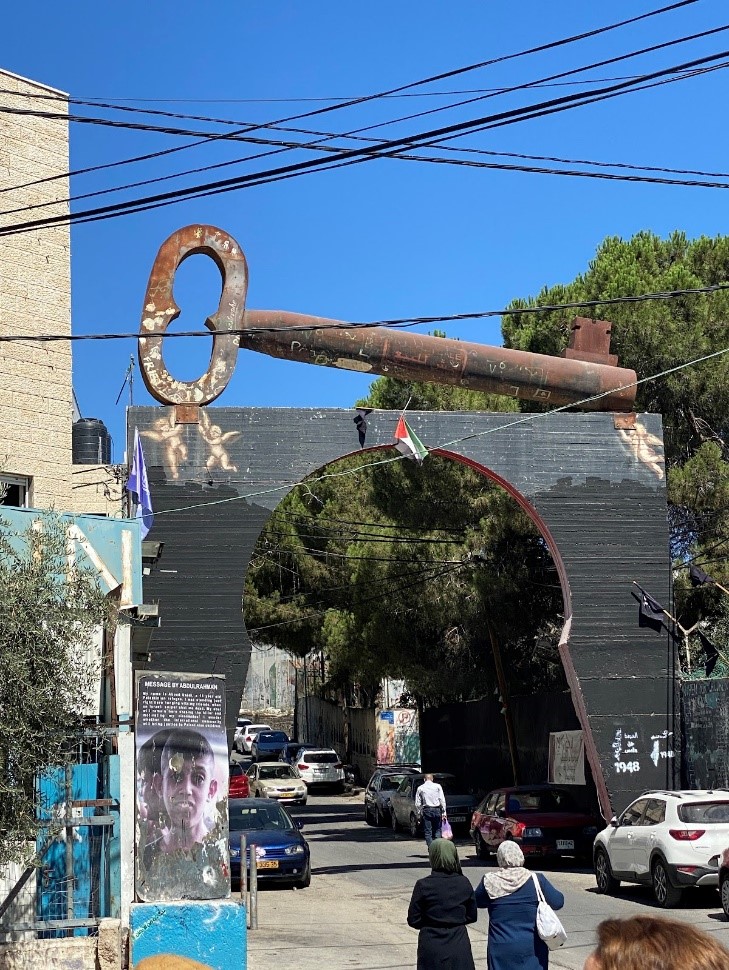
Caption: The key at the entrance to Aida Camp symbolizes the keys to Palestinian homes occupied during the Nakba. Many Palestinians still have the keys to their homes to symbolize how they will return one day.
“I feel like there is a soldier in my bedroom. I feel like there is a soldier in my kitchen.”
– Said, Aida Camp Guide
AIDA CAMP, BETHLEHEM—Aida means “to return” or “an act of kindness” in Arabic. For that reason, it is the perfect name for the Aida refugee camp, located north of the historic center of Bethlehem. It was named after a woman, Aida, who was kind to refugees, but also the hope that all refugees share, that they’ll return to their homes taken by the Israeli occupation.
As the IFP-Palestine students entered Aida Camp, it was hard to miss the giant statue of a key at the entrance. The key symbolizes the keys to Palestinian homes occupied during the Nakba. Many Palestinians still have the keys to their homes to symbolize how they will return one day.
Camp History:
Established in 1950, Aida is one of the smallest camps created by the United Nations Relief and Works Agency for Palestine Refugees—also known as UNRWA. UNRWA takes many actions to assist and protect “registered” Palestinian refugees, including enabling emergency food assistance and providing important resources to the 58 recognized Palestinian refugee camps.
At its advent, Aida was plagued by terrible health and living conditions. UNRWA did not—and still doesn’t—receive enough funding to adequately support refugees. The camp was supposed to be temporary, as UN Resolution 194 called for the right of return for refugees. However, when Israel refused and a durable solution to the Palestinian displacement seemed bleak, the refugee camp became increasingly permanent. Refugees had to integrate economically into the surrounding communities (Bethlehem) in order to support themselves outside of the meager aid from UNRWA.
So, the temporary housing became more concrete, in more ways than one. The house building process was very cooperative, as in Palestinian tradition. However, given the limited space and resources, the building mainly took the form of crowded neighborhoods with narrow streets and haphazardly built homes on top of one another. The bottom living space was built by the UN, but now some buildings have three more built up floors. The weak foundation is not meant to withstand the weight on top. Despite the safety risks, vertical building is only the viable solution to accommodate population growth in the camp. According to UNRWA, there are over 7,100 registered residents in the camp as of 2022, mostly refugees from Jerusalem and Hebron. However, that number may not accurately reflect the true population of refugees living there. Aida camp has an estimated population density of 77,464 per sq km. It only covers 0.71 sq kms.
Privacy is a luxury in the camp. During their visit, IFP students weaved their way through the camp's narrow allies to get the full picture of the cramped living situation and weak infrastructure.
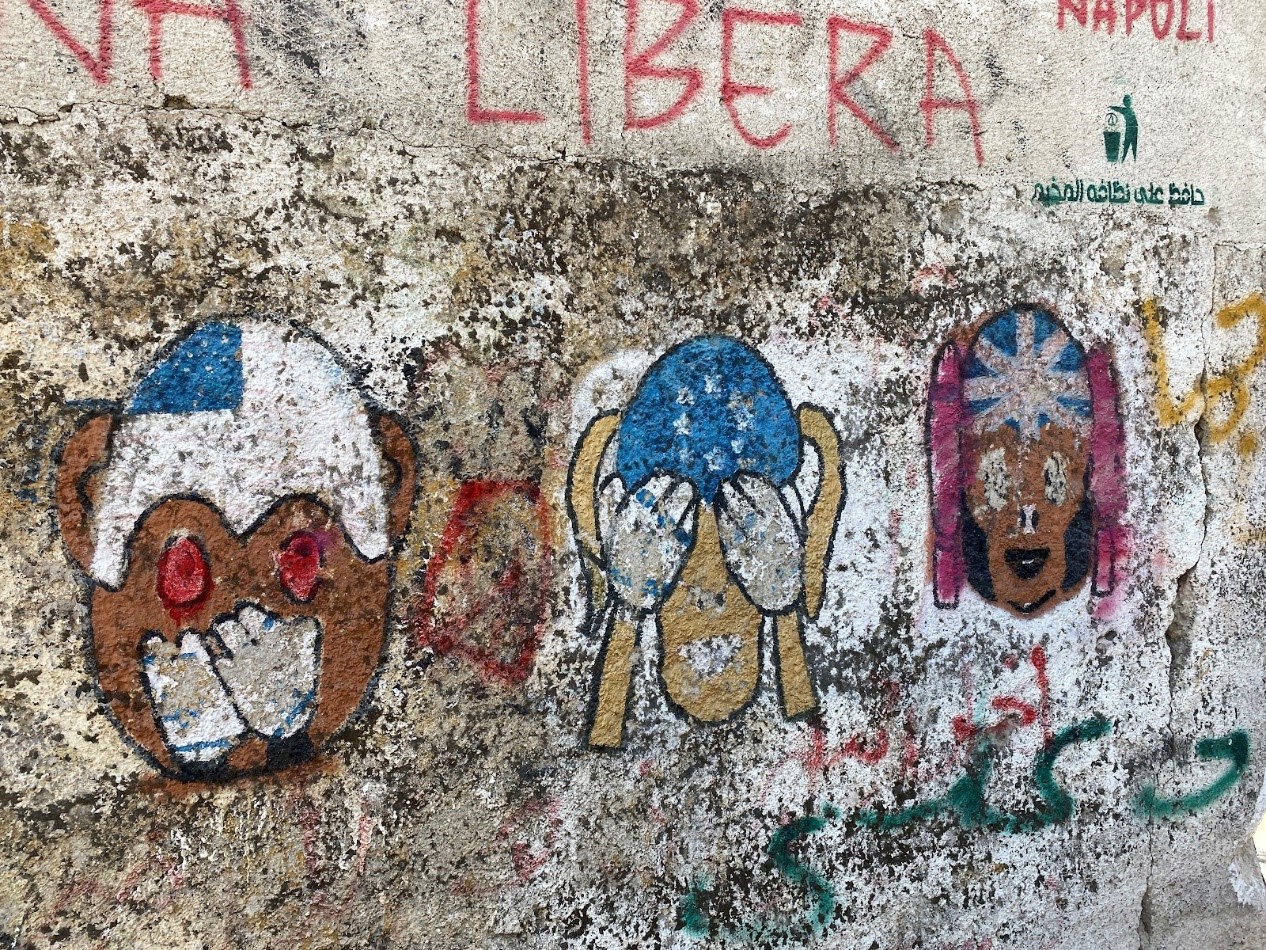
Caption: Monkeys representing the United States, the United Nations, and Great Britain are graffitied on the partition wall on the edge of Aida Camp. The image serves as a critique of how the governments have failed to support and protect Palestinian refugees from Israeli forces.
United States and UNRWA:
Currently, two United States Republicans stand in the way of 75 million US dollars in food assistance funding for Palestinian refugees.
US Rep. Mike McCaul and Sen. Jim Risch, top republicans in Congress's foreign affairs committees, used their positions to block previously earmarked aid to UNRWA, citing concerns over whether the agency promotes antisemitism or provides aid to Palestinian militants.
UNRWA notes that the aid hold would cause severe shortfalls if not resolved by September, potentially leaving more than 1.2 million people without necessary food assistance.
The situation is exacerbated by a May announcement that the World Food Programme will suspend food assistance to over 200,000 Palestinians because of monetary resource shortages.
In order for the aid to be distributed before the September deadline, UNRWA must agree to more oversight and accountability measures by the US, including implementing policies to prevent the dissemination of content deemed antisemitism, violent, or anti-Israeli
The US was the largest donor to UNRWA in 2022, contributing 344 million dollars. In comparison, the US sends Israel around 3.3 billion dollars in military funding every year. A much larger sum than goes to support Palestinians in need.
The visit to Aida was one of the first times IFP students had actually seen the UN’s presence explicitly in Palestine. There were UN flags, workers in vests, and UN labeled buildings around the camp. The aid in Aida appears to mostly be medical. Said, the tour guide for the day noted that, “They give us money to bandage ourselves.”
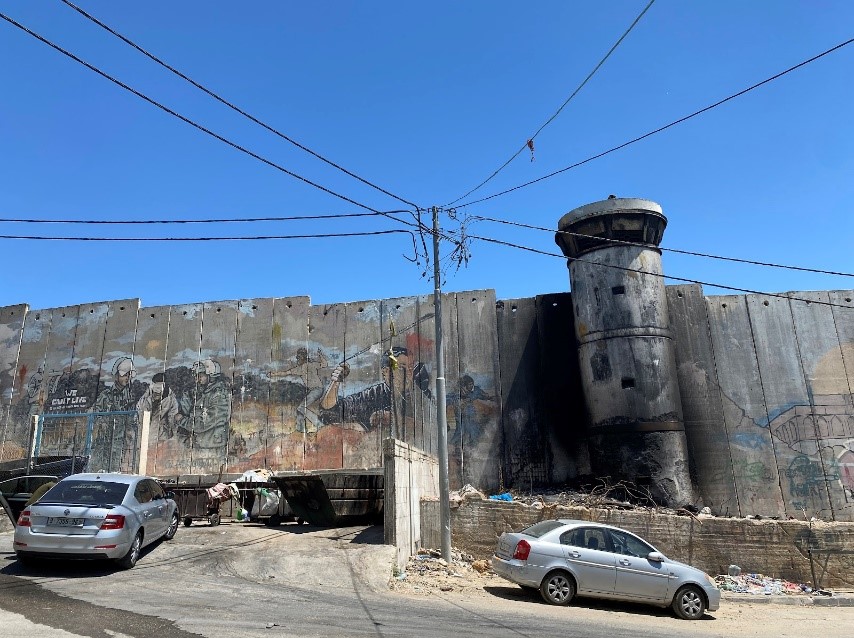
Caption: The partition wall next to Aida camp has seven watch towers. The watch tower pictured has been destroyed, but the surroundings still bear the scars of Israeli surveillance and attacks. The wall of the building opposite this tower is riddled with marks from bullets.
A Tour of Terror:
Much of the visit was cut with instances and images of Israeli violence. The market near the camp has been replaced with a military training base and the main street running through the camp, once called “The Live Street,” is now referred to as “The Ghost Street.”
It was hard to ignore the tall, graffitied partition wall running along the edge of the camp. The wall has 7 watch towers, however, the tower directly across from the camp was burned six years ago due to Palestinian resistance. Despite this, the surroundings still bear the scars of Israeli surveillance and attacks.
The wall of a building opposite this tower is riddled with bullet marks. The tour guide emphasized to the IFP students that the identity of the refugee residents is greatly impacted by the occupation. The amount of surveillance—from cameras, to soldiers, to automated machine guns along the edge of camp, to the presence of the wall in general—causes an inescapable need to self-police, which the guide noted created a “subjectivity of self.” For residents, it is difficult to have a personal conception of identity outside of the narratives perpetuated by the occupation and Israeli forces: Palestinian resistance to IDF violence mislabeled as “terrorism,” people displaced from their homes by the Nakba and continued Israeli colonization referred to as “present absentees,” etc.
In addition, the guide noted that the continued occupation also creates a sense of “landscape amnesia,” or “creeping normality,” where Israeli colonization is slowly normalized through small, incremental instances of oppression and change that would otherwise be obviously objectionable if it took place in a single event. An example of this was the “knock on the wall” system that was used heavily in the camp. In this tactic, IDF soldiers would knock on the doors of refugee homes and then plant bombs that would go off as the refugee approached the door.
The guide recounted the feeling of mental torture perpetuated by this tactic. Small signs of responses and adaptation to the occupation are present all over Aida. Instead of metal water towers, they have plastic ones that are easier to patch up when IDF soldiers use them for target practice. According to UC Berkeley, Aida is one of the most tear gassed places in the world. In a shop in the camp, they sell jewelry made from the gas canisters, canisters labeled “Made in the USA.”
IFP students left the camp with a greater understanding of the daily lives of Palestinian refugees and the struggles they face, but also with an appreciation for how they resist an exclusive narrative of victimization and still live their lives and celebrate their community.
Dispatch from Addameer الضمير – Wednesday, July 19, 2023
By Claire Schnatterbeck
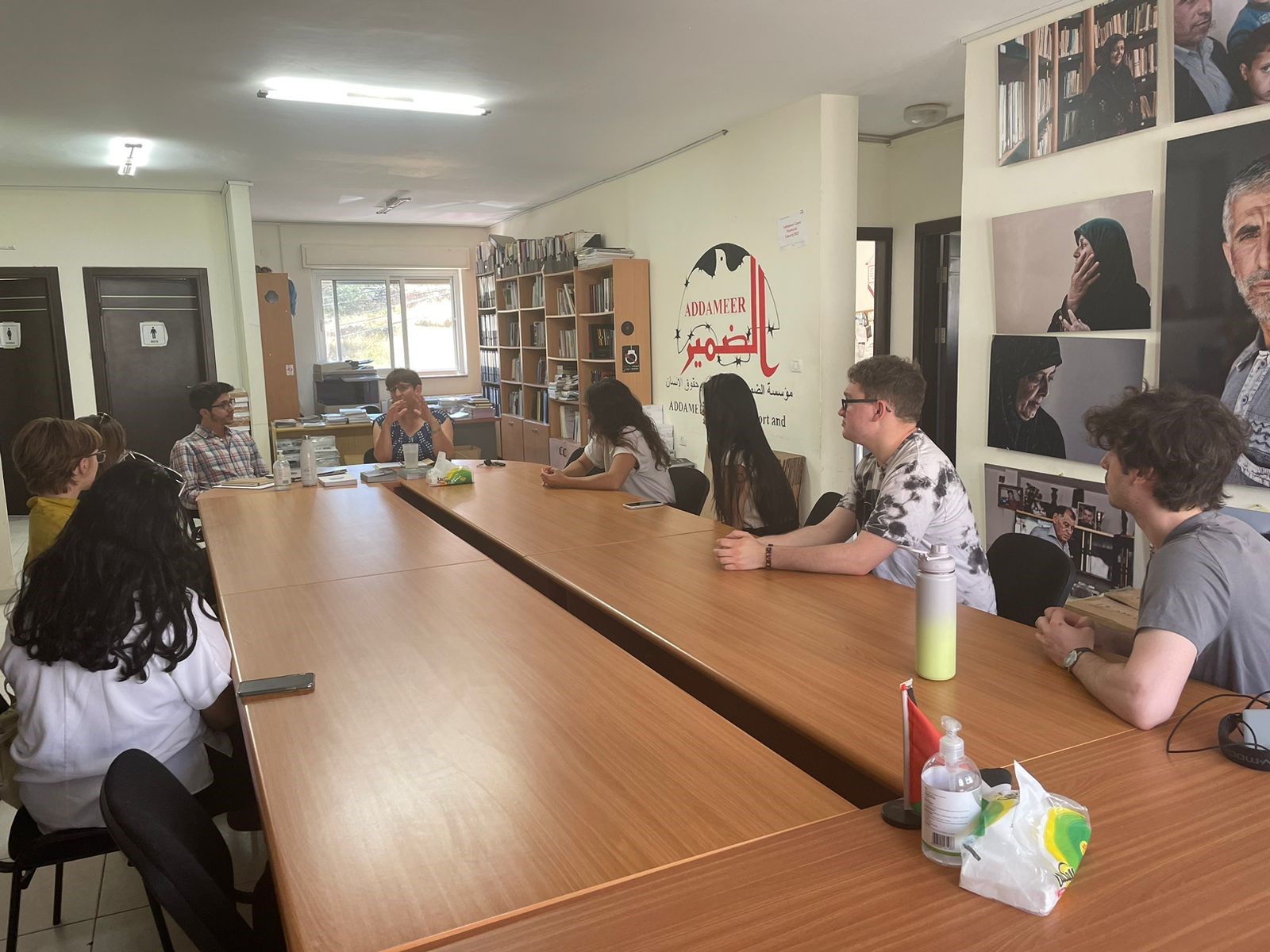
RAMALLAH, WEST BANK—On Wednesday, July 19th, IFP-Palestine students visited the Addameer Prisoner Support and Human Rights Association offices. The NGO—whose name means “conscience” in Arabic—is a civil institution working to support Palestinian political prisoners held in Israeli and Palestinian prisons.
Students met with Rami Kukhun and the director of Addameer, Sahar Fransise, to learn more about the organization's work to support prisoners. Fransise emphasized the critical health conditions in Israeli prisons and the lack of legal representation for prisoners going through the military court system. For example, many prisoners are denied translation services during their sentencing, leaving them confused and uninformed about what they are even being charged with and how long they will be in prison.
Fransise told students about the case of Walid Daqqa, a man who, at the age of 62, has spent 37 years in prison. Throughout his imprisonment, Daqqa published books and faced mistreatment and solitary confinement because of his activism. His family has recently applied for his release on health grounds after Daqqa was diagnosed with myelofibrosis, a rare bone marrow cancer. Because of medical negligence by the prison system, Daqqa is now unable to breathe without a respirator and deals with many complications from his illness. However, because he has a life sentence, the terms of his potential release are extremely complicated.
Constantly changing Israeli laws and prison policies make navigating its legal system incredibly difficult for prisoners and the organization who wish to help them. Addameer has faced many raids by Israeli forces and, in 2021, was labeled a terrorist organization by Israel, along with five other Palestinian non-profit NGOs (Al-Haq, Bisan Center for Research and Development, Defence for Children International, Union of Palestinian Women's Committees and Union of Agricultural Work Committees). Because of this label, Addameer cannot work directly with the lawyers who represent prisoners.
As the students were entering and exiting the offices, there were clear signs of how the IDF used explosives and force when they raided the offices, stealing computers, printers, and even office furniture. Fransise noted that these are simply methods of intimidation to limit the impact of Addameer and organizations like it. However, these organizations remain steadfast in their mission to “end torture and other violations of prisoners' rights through monitoring, legal procedures and solidarity campaigns.”
Dispatch from Hebron Pt. 1: In Situ الخليل – Saturday July 15, 2023
By Claire Schnatterbeck
“This narrative is less connected to the truth than to fabrication, forgery, and a theological mimicry fed by the burdens of colonialism and racism.” - In Situ Exhibition
EIN SARAH, HEBRON—On Saturday July 15th, IFP-Palestine students made the two hour trip to Hebron, a city in the southern West Bank. While Hebron is considered one of the oldest cities in the Levant, it is now an obvious pressure point for conflict between Palestinians and settler colonizers.
The visit to Hebron started with the Mandaloun Experimental Artlab “In Situ” Exhibition. The phrase “in situ” means associating an artifact with its original place. Archaeological artifacts are often removed from their original context by the passage of time or human imposition. The exhibit makes the argument that this phenomenon is all too common amongst Palestinian land colonized by Israel.
In the opening explanation of the exhibit, curator Izz Aljabari noted why this topic is particularly relevant to Hebron. He writes, “Hebron city is experiencing a cultural and societal change that horizontally and vertically disconnects the city from the extensive, deep-rooted, and accumulated history due to the state of settlement that the old town is undergoing and the disintegration in contexts of belonging and development in the city’s heart due to its ongoing divisions.” The archeological history of Tel Rumeida, an ancient city in the center of Hebron, is completely unknown outside of excavations conducted by the occupation.
It is not only a material, but a spiritual destruction of Palestinian history and identity. In the artist statement for his piece, In the Debris of Time…Towards Oblivion, Aljabari writes, “Ignorance of what lies beneath the ground hinders the formation of a comprehensive and coherent native for future generations, not only about the past but also about the present.”
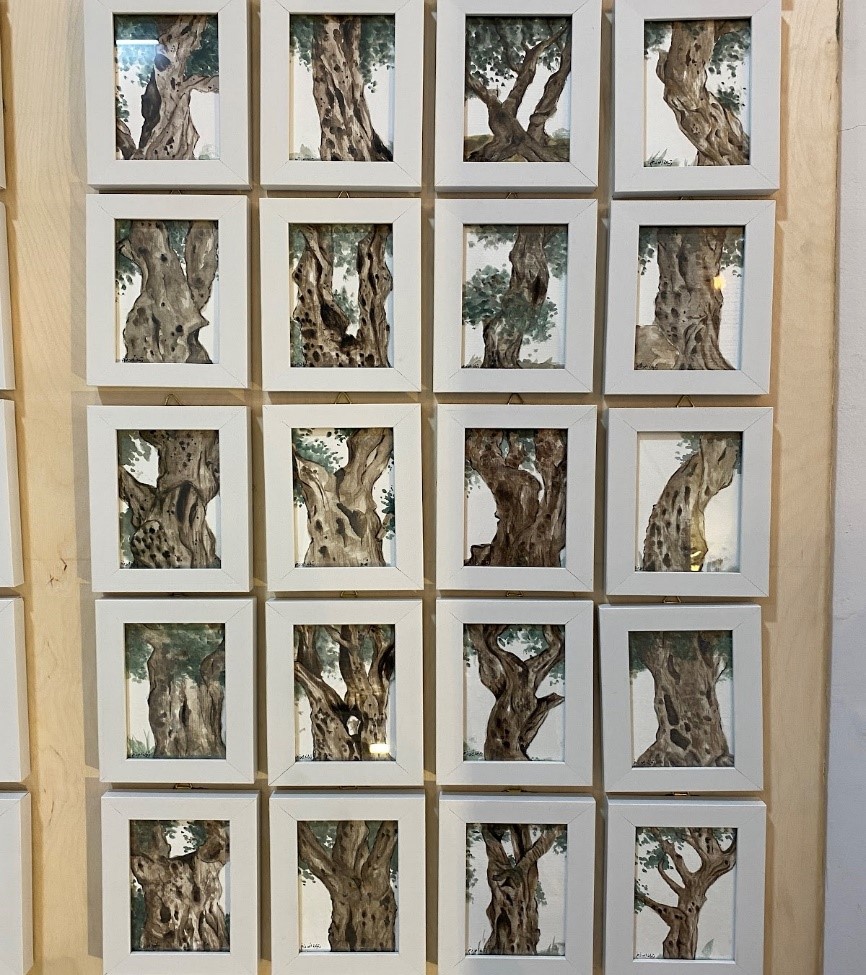
Caption: “Trees are born in the depths of Tel Aramida, with an unknown age, not due to the absence of knowledge but rather owing to their intricate nature. The olive, an eternal tree, withers from within and expands outward, thus lies the secret of the challenge in determining its age. This complex nature, akin to our own history, we wither from within and expand outward.” — The age remains undisclosed, yet it exists. by Rayyan Abu Zakham.
IFP students were confronted with the reality of the assertions made by the exhibit when they made their way to the old city part of Hebron. An Israeli settlement cuts through what was once a bustling market area, now replaced with facial recognition and security cameras, barbed wire crowned walls, and armed soldiers.
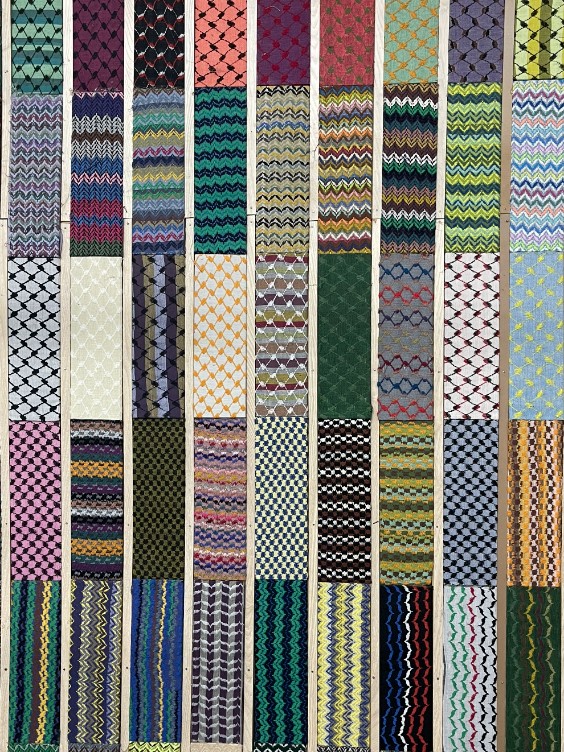
Caption: Depicted here are various patterns that make up the signature keffiyeh. The original colors of the keffiyeh are black and white; however, with its popularization, the Hirbawi factory has created many iterations of the scarf.
Dispatch from Hebron Pt. 2: The Hirbawi Factory الخليل – Saturday, July 15, 2023
By Maryam Shuaib
HEBRON, WEST BANK– Following the visit to the In Situ exhibition, IFP-Palestine students visited the Hirbawi Factory, which is currently the last standing factory that produces keffiyehs in all of Palestine. Founded by Yassar Hirbawi over sixty years ago, the Hirbawi factory is currently run by Yassar’s three sons and Izzat Hirbawi, a longtime friend of the family.
Given its family-oriented nature, the Hirbawi Factory confronts the challenges of the free market economy as a result of globalization. Competing cheap importations, primarily from China, make accessing the keffiyeh easier for worldwide consumers. However, the family owned factory struggles to maintain a growing supply of the popularized scarf. Despite this major obstruction, the Hirbawi family is committed to preserving the originality of the keffiyeh through native weaving practices.
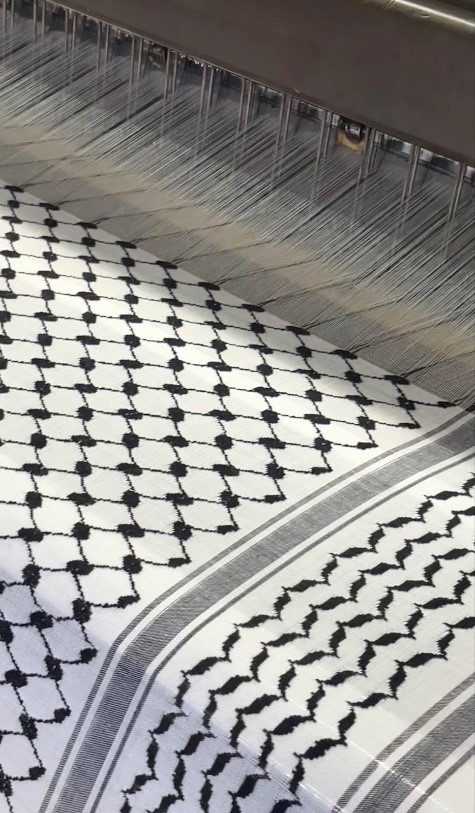
Caption: Cotton thread is intricately weaved by fifteen complex industrial looms to create the notable keffiyeh pattern. The black and white color scheme is the original iteration of the scarf, and makes up seventy percent of the factory’s sales.
While touring the factory, students were able to see, first hand, the mechanized weaving techniques that are utilized to manufacture each individual keffiyeh. The industrial looms require constant monitoring to ensure that the process of production is seamless. All repairs are done by hand, which contributes to the meticulous training that accompanies the Hirbawi family’s goal of sustaining the family owned factory. The small-scale production of keffiyehs maintains the vessel of resistance that is emulated by the kuffiyeh’s pattern.
Often alluded to as the unofficial flag of Palestine, the keffiyeh comprises three patterns. The fishnet pattern dominates most of the fabric, as it represents the collectivism that accompanies Palestinian identity. The thick borders represent the entangling trade routes that provided economic advantages to Palestinians. The bird-like motif is reminiscent of olive leaves, thus visually representing the olive tree’s importance to Palestinian life, and identity by extension.
The existence of the Hirbawi factory is a quintessential symbol of resistance to the destructive nature of the occupation. Despite Hebron’s divisive dynamic, the factory continues to produce and ship the most authentic form of Palestinian identity while also challenging the convenience of globalization.
Dispatch from Sakiya ساقية – Friday, July 14, 2023
By Claire Schnatterbeck and Maryam Shuaib
“It’s about showing how enriching this kind of life can be…spaces have a pedagogy of their own.” – Tareq Khalaf, Sakiya
EIN QINIYA, WEST BANK—On Friday, July 14th, students from the International Field Program-Palestine program visited Sakiya, an educational space that combines agrarian traditions with art and ecology. Throughout the visit, students were not only shown the incredible landscape and gardens, but asked to examine the importance of sharing traditional knowledge in Palestine. In a country with much of its history and knowledge destroyed or manipulated by the ongoing Israeli occupation, Sakiya seeks to emphasize experiential learning as a way to derive wisdom from what is tangible in nature, while also connecting to traditional roots.
While land usage is a powerful tool of Israeli control, it is also a form of Palestinian resistance. There is a common perception that land is considered wasted if one does not exploit it of all existent resources. An Ottoman Era law—currently enforced by Israel for the purpose of obtaining Palestinian land—states that any plot of land not cultivated for three years, or with less than half its area cultivated, must be returned to state ownership. The appropriation of much of the West Bank has resulted from Ottoman Era law and meticulously calculated legal standards, which has contributed to minimizing the sustenance of the land to Palestinians.
Sakiya, however, aspires to be in harmony with its environment, for example, utilizing natural springs and channels from hundreds of years ago to irrigate its crops. While the students were visiting, two different herds of sheep came to graze. Tareq Khalaf, who led the tour and works full-time at Sakiya, emphasized the importance of interconnectedness between every animal and human. He noted that, when restoring and renovating Sakiya, they keep in mind the sheep, bats, frogs, etc. who also utilize the land and contribute to its sustainability.
The existence of Sakiya, as an organization, is a form of Palestinian resistance that seeks to reinstate a system of ethics and culture through prioritizing the native Palestinian environmental landscape. Sakiya confronts the challenges that are presented with the popularization of an urbanized landscape, and the waste that results from it. The collective labor that contributes to the conservation of Ein Qiniya emulates the possibility of an alternative lifestyle that utilizes ecological strategies of resistance against illegal land dispossession.
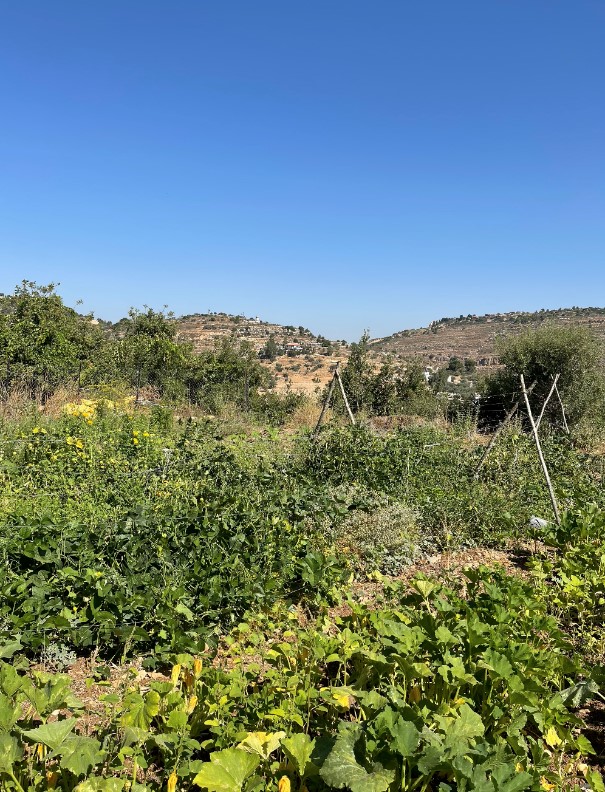
Caption: IFP Palestine students embarked on collective labor as they picked crops to prepare for a collective meal with Tareq Khalaf.
Collective labor and building community are also important parts of Sakiya’s mission. While visiting, IFP students worked together to pick vegetables from the garden, cook, and share a meal of shakshuka, humus, and bread. Khalaf noted how the organization tries to engage the community around Sakiya, artists in residence, and international visitors to share their knowledge and learn through educational programing and volunteer opportunities for all ages.
IFP students left Sakiya with full stomachs and a deeper understanding of work happening within Palestine to not only cultivate crops, but also cultural understanding and traditions.
IFP participate and New School GPIA Graduate student Christina Wong is completing an internship at Sakiya during the program.
Dispatch from PBC هيئة الإذاعة والتلفزيون الفلسطينية – Thursday, July 13, 2023
By Claire Schnatterbeck
RAMALLAH, WEST BANK—On Thursday, July 13th, students from the International Field Program-Palestine program visited the office of the Palestinian Broadcasting Corporation (PBC), Palestine’s public national news organization. The organization produces radio and television with the goal to promote Palestinians “basic rights to liberation, independence, and the establishment of its independent state on the homeland.”
With that mission, PBC produces news, cultural programming, and entertainment for Palestinians at home and in the diaspora. While visiting, students met the editor-in-chief of the Palestine TV news department to discuss the organization's impact on Palestinians, but also the challenges it faces as a national media outlet under ongoing Israeli occupation. The editor-in-chief responded to students' questions about being a national news source countering a narrative controlled by the occupying force. Much of PBCs reporting focuses on the actions of Israeli forces and settler colonizers on Palestinians. PBC has offices in cities all over Palestine in order to report timely news about the occupation. However, its reporters and cameras are often targeted by Israeli forces. The offices have even been attacked and raided, including the old Ramallah office, which was bombed in 2002.
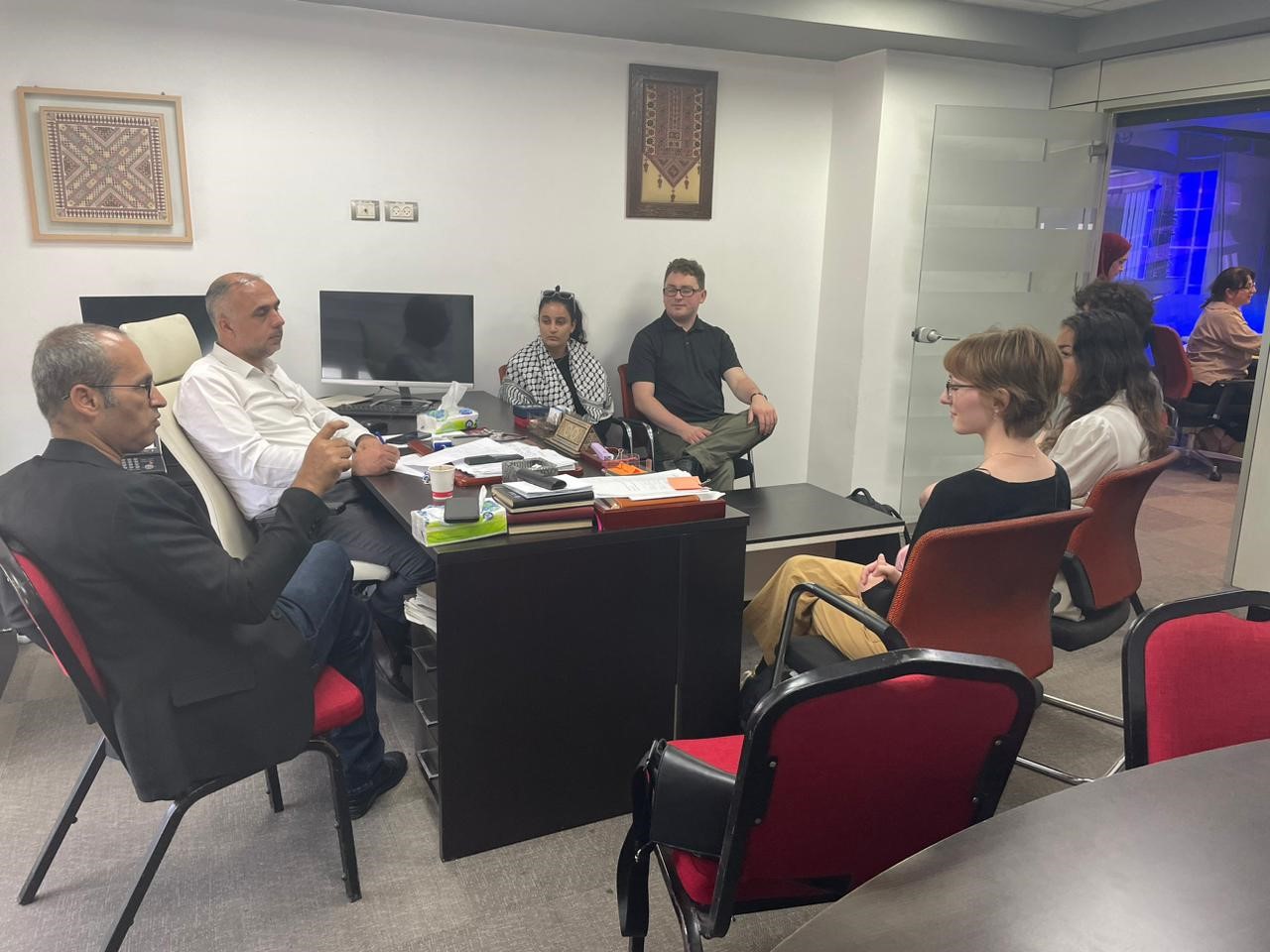
Caption: IFP students ask PBCs editor-in-chief of news questions while Osama Nazzal, the head of the International Broadcast department translates.
During the tour, IFP students also got to see the TV sound stages and radio recording studios. Students spent the most time visiting with the International Broadcast department (PBI), a small group of journalists who create and translate content into seven languages, including English. Their content is geared towards Palestinians in the diaspora, as well as the people living in places where Palestinians end up. The PBI team took the time to discuss with the IFP students about their decision to visit Palestine. They noted that understanding an American perspective of Palestine helps them create social media postings and tell stories that will spread awareness. Osama Nazzal, the head of PBI, emphasized the importance of creating content that resonates with American audiences in order to not only educate about the reality of life in Palestine, but create solidarity.
IFP participate and Columbia University undergraduate student Claire Schnatterbeck is completing an internship at the Palestinian Broadcasting Corporation during the program.

